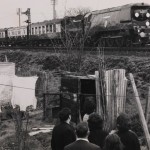The National Railway Museum is delving into the mind of today’s trainspotter, with a fresh exploration of the much misunderstood hobby.
Visitors to ‘Trainspotting’ will be able to experience the strong sense of anticipation that has motivated many rail fans throughout the ages.
The commission by artist Andrew Cross is set to open in 6 month’s time to mark the anniversary of the world’s first ever child trainspotter.
Jonathan Backhouse’s letter to his sisters describing the opening of the Stockton and Darlington Railway in September 1825 is part of the York museum’s collection of priceless railway artefacts and is recognised as the world’s first instance of trainspotting.
Amy Banks, Interpretation Developer at the National Railway Museum said: “Trainspotting was one of the most common hobbies for boys in the 1950s, 60s and 70s, but we have asked artists to explore what it means today.”
Self-confessed trainspotter Andrew Cross was appointed out of a shortlist of 120 artists from all over the UK and overseas, to create a fresh interpretation of the topic which could be described as the final taboo for dinner party discussion.
Says Andrew: “I was delighted to be selected by the National Railway Museum against what I understand to be incredibly strong competition. As one of those 70s schoolboys grown up I feel I can add a real sense of personal experience – to recreate the sense of exploration, anticipation, and the final drama.

‘4CEP’ electric locomotive near Faversham, Kent, 1959.
“I see trainspotting as one of the last remaining radical stances you can take. At a dinner party you can confess to all manner of things and noone will turn a hair, but if you were to say you like trains you can see a palpable disquiet among your fellow guests who may not understand your motivation.
“Trainspotters demonstrate the ability of individuals to act freely in pursuit of their interests simply because they are not influenced by fashion or social expectation.”
Andrew uses personal memories of a childhood spent travelling the tracks plus contemporary film work to create the collective experience that links the nostalgic pastime with the international perspective of the present day.
Amy concludes: “We chose Andrew because his work has a strong sense of authenticity and he took his response to the theme right up to the present day, when technology has changed the landscape irrevocably.”
The project is supported using public funding by the National Lottery through Arts Council England due to its artistic credentials.
Trainspotting opens 26 September 2014 – 1 March 2015 at the National Railway Museum.
For more information visit. www.nrm.org.uk/trainspotting.
Featured image:Schoolboy train-spotters at Newcastle Station, August 1950.
Credit © Daily Herald Archive/National Media Museum / Science & Society Picture Library
‘4CEP’ electric locomotive near Faversham, Kent, 1959. Photograph by Patrick Ransome-Wallis, showing boys standing by a level crossing watching the train approach. One boy has squeezed into the gap between the gate and the post.
Credit © National Railway Museum / Science & Society Picture Library




